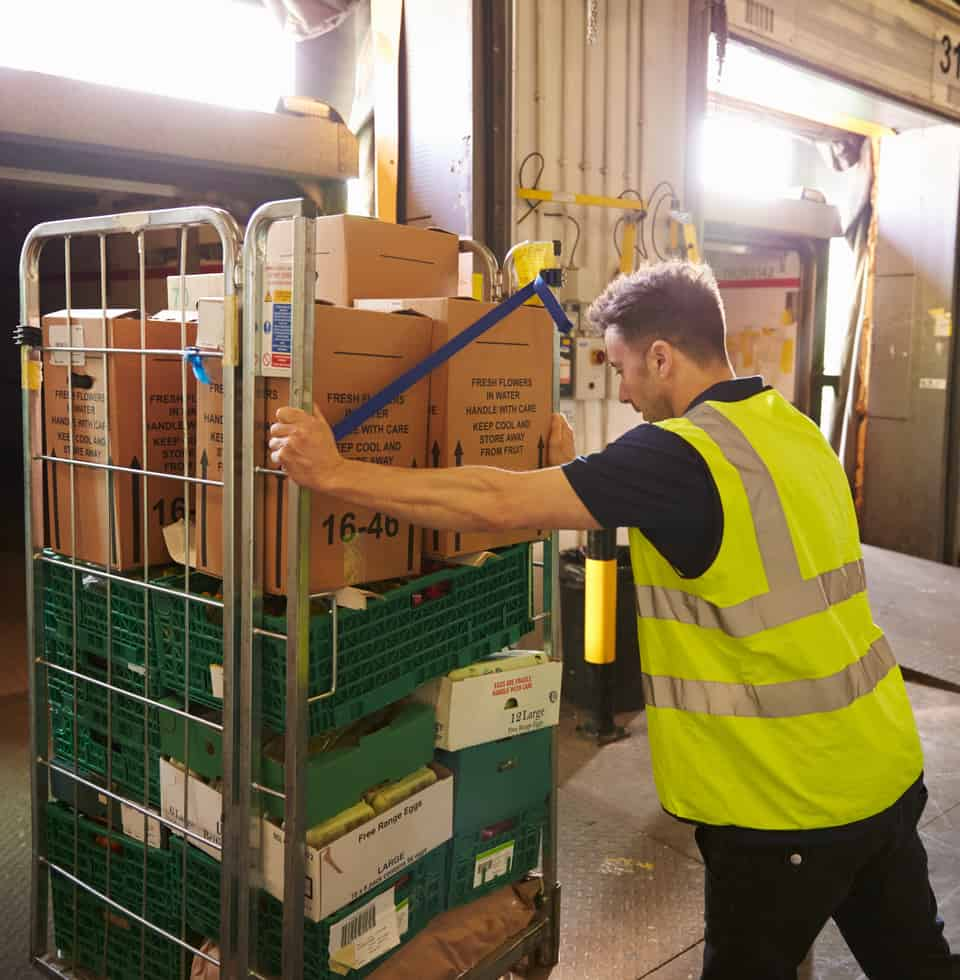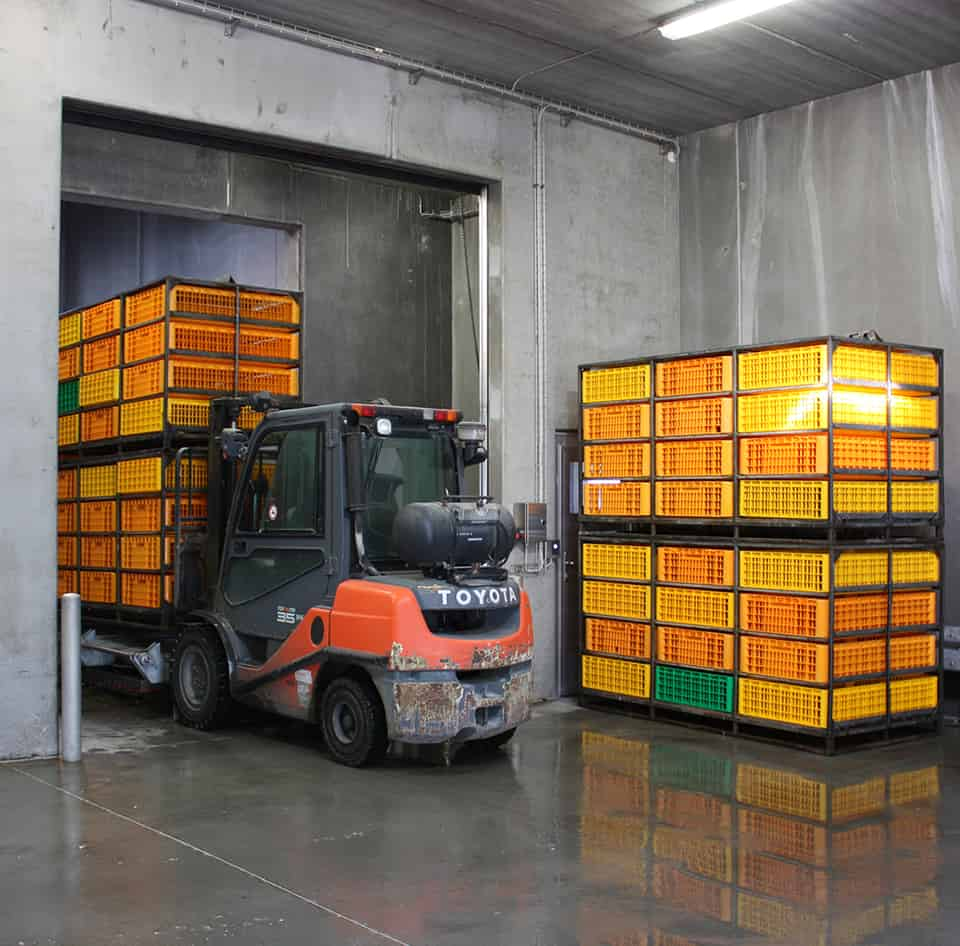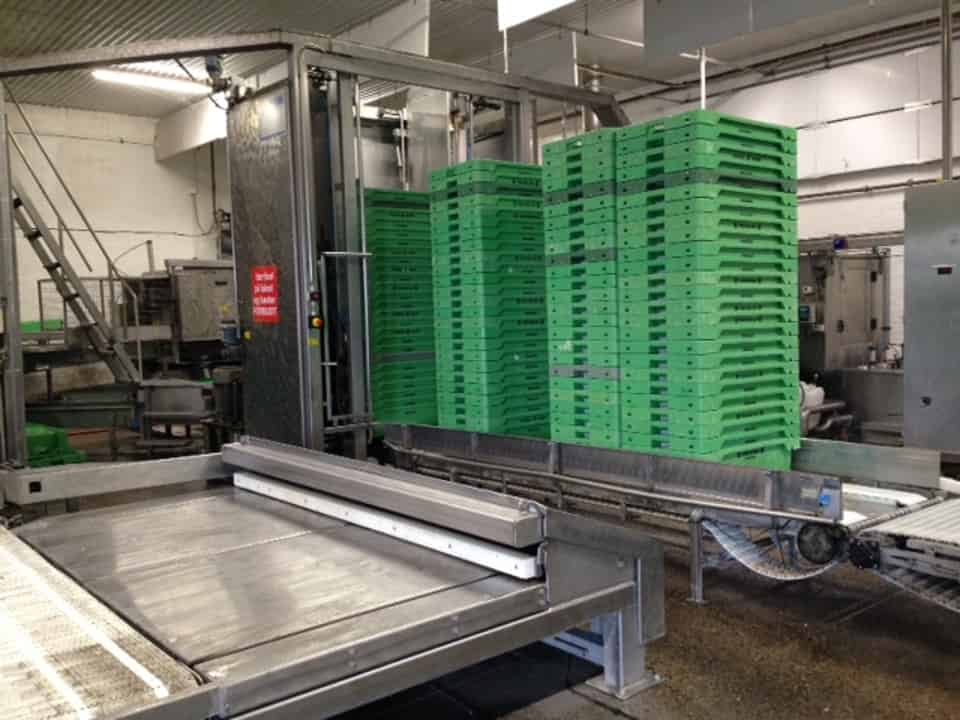Introduction to RTI tracking
Returnable Transport Items (RTIs) form an indispensable part of modern supply chains that facilitate the efficient movement of goods from one point to another. These items, which include pallets, milk boxes, fish container boxes, roller cages, containers, and totes, are designed to be reused multiple times. Thus reducing the need for single-use packaging and minimizes waste. However, managing RTIs effectively presents significant challenges for businesses, particularly in terms of tracking their location, condition, and usage throughout the supply chain.
RTI tracking involves the use of technology and systems to monitor the movement and status of these reusable assets in real-time. By implementing RTI tracking solutions, organizations can gain valuable insights into the whereabouts of their assets, optimize their utilization, and mitigate the risk of loss or theft. This proactive approach to RTI management not only enhances operational efficiency, but also drives cost savings and improves collaboration with trading partners.
In this article, we will explore the importance of RTI tracking in modern logistics and supply chain management. We will delve into the challenges associated with managing RTIs, discuss the benefits of implementing tracking solutions, and examine the various technologies and best practices involved. Whether you're a logistics professional seeking to optimize your operations or a business owner looking to streamline your supply chain processes, this guide will provide valuable insights into the world of RTI tracking and its transformative potential.


Challenges in RTI management:
Despite their importance in facilitating the movement of goods, managing RTIs poses several significant challenges for organizations across industries. These challenges can impede operational efficiency, increase costs, and hinder the seamless flow of goods within the supply chain. Here are some common challenges associated with RTI management:
- Loss and theft: RTIs are often lost, misplaced, or stolen during transit or while in storage, leading to inventory discrepancies and financial losses for businesses. The lack of visibility into the location of RTIs makes it difficult to track and recover them effectively.
- Inefficiency in asset utilization: Without proper tracking mechanisms in place, organizations may struggle to optimize the utilization of their RTIs. Assets may sit idle in warehouses or be underutilized, resulting in wasted resources and increased operational costs.
- Manual tracking processes: Many organizations still rely on manual methods, such as spreadsheets or paper-based systems, to track RTIs. These manual processes are prone to errors, delays, and inaccuracies, making it challenging to maintain an accurate inventory of assets.
- Disputes with trading partners: Inaccurate or incomplete information about the location and condition of RTIs can lead to disputes between trading partners. Disagreements over ownership, responsibility, and liability for lost or damaged assets can strain business relationships and impact supply chain collaboration.
- Lack of standardization: The absence of standardized tracking protocols and technologies across the supply chain can complicate RTI management efforts. Different stakeholders may use incompatible systems or formats, making it challenging to share information and coordinate activities effectively.
Addressing these challenges requires a proactive approach to RTI management, leveraging advanced tracking technologies and best practices to enhance visibility, optimize asset utilization, and improve collaboration across the supply chain. In the following sections, we will explore the benefits of RTI tracking solutions and discuss strategies for overcoming these challenges effectively.
Benefits of RTI tracking
Implementing RTI tracking solutions offers a wide range of benefits to organizations looking to streamline their supply chain operations and enhance efficiency. By leveraging advanced technology and data-driven insights, businesses can overcome the challenges associated with RTI management and unlock significant value throughout the supply chain. Here are some key benefits of RTI tracking:
Improved visibility
RTI tracking offers real-time updates on asset location and status, helping organizations track goods, identify bottlenecks, and quickly adjust to changes in demand or logistics.
Optimized asset utilization
RTI tracking enables businesses to identify underused assets, redistribute them, and allocate resources efficiently across the supply chain, reducing waste and improving overall utilization.
Reduced loss and theft
RTI tracking uses RFID, BLE, and GPS to monitor assets, helping prevent unauthorized use, detect losses, and recover stolen items faster.
Enhanced collaboration
RTI tracking shares real-time data with stakeholders, improving coordination, automating actions like invoicing, and reducing disputes, which strengthens supply chain relationships.
Cost savings
By reducing asset loss, optimizing utilization, and improving efficiency, RTI tracking minimizes replacement costs, mitigates risks, and delivers significant savings.
Retain Revenue
RTI tracking reduces asset loss and theft, ensuring goods are delivered as planned. By maintaining supply chain continuity, businesses prevent revenue loss and improve customer satisfaction.
Overall, RTI tracking solutions offer a comprehensive approach to managing reusable assets in the supply chain, enabling organizations to streamline operations, reduce costs, and drive value creation. In the following sections, we will explore the various technologies and best practices involved in RTI tracking, providing practical insights for organizations that seek to optimize their supply chain management processes.

Types of RTI tracking technologies
Various technologies are available for implementing RTI tracking solutions, each offering unique capabilities and benefits. Understanding the different types of tracking technologies can help organizations choose the most suitable solution based on their specific requirements and operational needs. Here are some common RTI tracking technologies:
1. Radio frequency identification (RFID):
- RFID technology utilizes radio waves to wirelessly identify and track RTIs equipped with RFID tags or labels.
- RFID tags contain unique identifiers that can be read by RFID readers, enabling automatic identification and data capture.
- RFID offers real-time visibility into RTI movements and can be used to track assets throughout the supply chain, from production facilities to warehouses and distribution centers.
- RFID technology is highly scalable and can support large-scale RTI tracking deployments across multiple locations.
2. Bluetooth low energy (BLE) beacons:
- BLE beacons are small, battery-powered devices that emit Bluetooth signals to communicate with nearby smart devices (e.g. smart phones carried by last mile drivers).
- BLE technology can be used to track RTIs within close proximity to Bluetooth-enabled devices, such as smartphones or dedicated receivers installed in warehouses or distribution centres.
- BLE beacons offer a cost-effective and energy-efficient solution for indoor RTI tracking, providing location-based services and proximity detection capabilities.
- However, BLE tracking is limited by range and may require additional infrastructure to achieve comprehensive coverage across large facilities or outdoor environments.
3. Global positioning system (GPS) tracking:
- GPS tracking technology utilizes satellite signals to determine the precise location of RTIs equipped with GPS-enabled devices, or equipped with BLE technology that can be read by a smart device with GPS tracking capabilities available.
- GPS tracking provides real-time location updates and can be used to track assets in transit or in remote locations where other tracking technologies may not be feasible.
- GPS tracking is particularly useful for monitoring high-value or high-risk RTIs, such as sensitive equipment or hazardous materials, and for ensuring compliance with transportation regulations.
- However, GPS tracking may be less suitable for indoor or densely populated environments where satellite signals may be obstructed or unreliable.
4. Barcode (or QR-code) scanning systems:
- Barcode scanning systems involve the use of barcoded labels or tags affixed to RTIs, which are scanned using handheld or stationary barcode scanners.
- Barcodes contain encoded information about the RTI, such as its serial number or tracking ID, which is captured and recorded in a database.
- Barcode scanning systems are cost-effective and easy to implement, making them suitable for organizations with basic tracking requirements or limited budgets.
- However, barcode scanning systems require line-of-sight access to labels, and manual scanning processes can be labor-intensive and prone to errors.
By understanding the capabilities and limitations of different tracking technologies, organizations can make informed decisions when selecting the most suitable RTI tracking solution for their specific use cases and operational environments. In the following sections, we will explore implementation considerations and best practices for deploying RTI tracking solutions effectively.
Implementation considerations
Successfully implementing RTI tracking solutions requires careful planning, consideration of various factors, and adherence to best practices. From selecting the right technology to ensuring seamless integration with existing systems, organizations must address several key implementation considerations to maximize the effectiveness and efficiency of their RTI tracking initiatives. Below are some important factors to consider:
1. Technology selection:
Evaluate different RTI tracking technologies based on your specific requirements, budget, and operational needs. Consider factors such as coverage range, accuracy, scalability, and compatibility with existing infrastructure and systems.
2. Tagging strategy:
Develop a comprehensive tagging strategy to ensure proper identification and tracking of RTIs throughout the supply chain. Determine the placement of tags on RTIs, tag encoding protocols, and reader deployment locations to optimize visibility and data capture.
3. Data management and integration:
Establish robust data management processes and systems to collect, store, and analyze RTI tracking data effectively. Ensure seamless integration with existing enterprise resource planning (ERP) systems, warehouse management systems (WMS), and other relevant software applications to enable real-time visibility and actionable insights.
4. Infrastructure requirements:
Assess the infrastructure requirements for deploying RTI tracking solutions, including the installation of RFID readers, barcode scanners, GPS enabled smart devices, and/or BLE beacons. Consider factors such as network connectivity, power supply, environmental conditions, and regulatory compliance when designing the tracking infrastructure.
5. Training and adoption:
Provide comprehensive training and support to employees involved in RTI tracking operations to ensure proper usage of tracking technology and adherence to tracking protocols. Foster a culture of accountability and responsibility for RTI management across the organization to maximize the effectiveness of tracking initiatives.
6. Security and privacy:
Implement appropriate security measures to protect RTI tracking data from unauthorized access, manipulation, or theft. Ensure compliance with data privacy regulations and industry standards to safeguard sensitive information and preserve the integrity of tracking systems.
7. Performance metrics and KPIs:
Define key performance indicators (KPIs) and metrics to measure the effectiveness and ROI of RTI tracking initiatives. Monitor metrics such as asset utilization rates, inventory accuracy, loss prevention, and operational efficiency to identify areas for improvement and optimization.
8. Continuous improvement:
Regularly evaluate and optimize RTI tracking processes and systems based on feedback, performance data, and emerging technologies. Identify opportunities for innovation and process enhancement to drive continuous improvement and maintain a competitive edge in the market.
By addressing these implementation considerations proactively, organizations can deploy RTI tracking solutions effectively and realize tangible benefits in terms of operational efficiency, cost savings, and supply chain visibility. In the following sections, we will explore case studies and success stories of organizations that have successfully implemented RTI tracking initiatives and achieved significant improvements in their supply chain operations.
Our case studies
Across various industries, organizations are implementing innovative solutions to track Returnable Transport Items (RTIs) effectively. From airports to healthcare facilities, libraries to logistics companies, and postal services, RTI tracking technologies are revolutionizing asset management and improving operational efficiency.
Best practices for RTI tracking
By using the best practices of RTI tracking your organization can maximize the benefits of RTI tracking and optimize their supply chain operations. Some of the most important factors are listed below:
Clear objectives
Define specific objectives for RTI tracking initiatives, such as improving asset visibility, reducing loss, or enhancing operational efficiency.
Technology selection
Choose the most suitable tracking technology based on your requirements, considering factors like coverage range, accuracy, and integration capabilities.
Comprehensive tagging
Ensure all RTIs are properly tagged with RFID, barcode and/or BLE and enable GPS usage on smart devices to enable accurate tracking and monitoring.
Data integration
Integrate RTI tracking data with existing systems, such as ERP or WMS, to enable seamless data exchange and real-time visibility.
Standardized processes
Establish standardized processes and protocols for RTI management, including tagging, tracking, and maintenance procedures.
Training and education
Provide comprehensive training to employees involved in RTI tracking to ensure proper usage of technology and adherence to protocols.
Regular maintenance
Implement regular maintenance checks for tracking devices and RTIs to ensure optimal performance and reliability.
Performance monitoring
Continuously monitor key performance indicators (KPIs) to evaluate the effectiveness of RTI tracking initiatives and identify areas for improvement.
Future trends and innovations in RTI tracking:
As technology continues to advance, the landscape of RTI tracking is evolving rapidly. Some emerging trends and innovations include:
- Artificial intelligence (AI) for predictive maintenance: AI-powered algorithms can analyze data from RTI tracking systems to predict maintenance needs, identify potential issues before they occur, and optimize asset performance.
- Blockchain for secure and transparent tracking: Blockchain technology offers immutable and transparent tracking of RTIs, ensuring data integrity and security throughout the supply chain. It enables enhanced traceability and accountability, reducing the risk of fraud or tampering.
- IoT (Internet of Things) integration for real-time monitoring: Integration of IoT devices with RTI tracking systems enables real-time monitoring of assets, allowing for proactive decision-making and immediate response to changes or disruptions in the supply chain.
These trends signify a shift towards more advanced and interconnected RTI tracking solutions, offering greater visibility, efficiency, and reliability in supply chain management.

Leading the way in RFID tracking technology with Lyngsoe Systems
At Lyngsoe Systems, we are leaders in the field of RTI tracking, committed to delivering both standard and tailored solutions that meet the specific needs of each customer. With a strong focus on innovation and customer satisfaction, our technology-agnostic approach ensures that you receive the optimal solution to enhance your inventory management, maximize asset utilization, streamline operations, and elevate the customer experience.
Our team of experts is dedicated to guiding you through the transformative power of RTI tracking in logistics operations. Whether you seek improved visibility, increased efficiency, or cost savings, Lyngsoe Systems leads the way.
Contact us today to speak with one of our experts and discover how our asset tracking solutions can revolutionize your logistics operations.

FAQ
Why is tracking RTIs important?
Effective RTI tracking provides real-time visibility into the location and status of these assets, helping organizations to reduce loss and theft, optimize asset utilization, minimize manual tracking efforts and lower operational costs.
How does RTI tracking contribute to sustainability?
By ensuring RTIs are efficiently utilized and returned, you reduce the need for single-use packaging, minimize waste, and can plan any necessary maintenance, extending the lifespan of your RTIs.
Can Lyngsoe’s solution integrate with existing systems?
Our tracking solutions are designed to seamlessly integrate with existing enterprise systems such as ERP, WMS, TMS, and BI platforms through APIs, ensuring smooth data flow and operational continuity.


